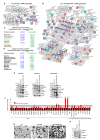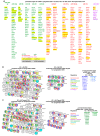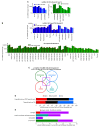Tspan8-Tumor Extracellular Vesicle-Induced Endothelial Cell and Fibroblast Remodeling Relies on the Target Cell-Selective Response
- PMID: 32013145
- PMCID: PMC7072212
- DOI: 10.3390/cells9020319
Tspan8-Tumor Extracellular Vesicle-Induced Endothelial Cell and Fibroblast Remodeling Relies on the Target Cell-Selective Response
Abstract
Tumor cell-derived extracellular vesicles (TEX) expressing tetraspanin Tspan8-alpha4/beta1 support angiogenesis. Tspan8-alpha6/beta4 facilitates lung premetastatic niche establishment. TEX-promoted target reprogramming is still being disputed, we explored rat endothelial cell (EC) and lung fibroblast (Fb) mRNA and miRNA profile changes after coculture with TEX. TEX were derived from non-metastatic BSp73AS (AS) or metastatic BSp73ASML (ASML) rat tumor lines transfected with Tspan8 (AS-Tspan8) or Tspan8-shRNA (ASML-Tspan8kd). mRNA was analyzed by deep sequencing and miRNA by array analysis of EC and Fb before and after coculture with TEX. EC and Fb responded more vigorously to AS-Tspan8- than AS-TEX. Though EC and Fb responses differed, both cell lines predominantly responded to membrane receptor activation with upregulation and activation of signaling molecules and transcription factors. Minor TEX-initiated changes in the miRNA profile relied, at least partly, on long noncoding RNA (lncRNA) that also affected chromosome organization and mRNA processing. These analyses uncovered three important points. TEX activate target cell autonomous programs. Responses are initiated by TEX targeting units and are target cell-specific. The strong TEX-promoted lncRNA impact reflects lncRNA shuttling and location-dependent distinct activities. These informations urge for an in depth exploration on the mode of TEX-initiated target cell-specific remodeling including, as a major factor, lncRNA.
Keywords: endothelial cells; fibroblasts; mRNA; message transfer; ncRNA; non-transformed target remodeling; tetraspanin 8; tumor exosomes.
Conflict of interest statement
The authors declare no conflict of interest.
Figures













Similar articles
-
Pancreatic cancer-initiating cell exosome message transfer into noncancer-initiating cells: the importance of CD44v6 in reprogramming.J Exp Clin Cancer Res. 2019 Mar 19;38(1):132. doi: 10.1186/s13046-019-1129-8. J Exp Clin Cancer Res. 2019. Retraction in: J Exp Clin Cancer Res. 2025 Feb 28;44(1):78. doi: 10.1186/s13046-025-03339-1. PMID: 30890157 Free PMC article. Retracted.
-
The tetraspanins CD151 and Tspan8 are essential exosome components for the crosstalk between cancer initiating cells and their surrounding.Oncotarget. 2015 Feb 10;6(4):2366-84. doi: 10.18632/oncotarget.2958. Oncotarget. 2015. PMID: 25544774 Free PMC article.
-
Tspan8 and Tspan8/CD151 knockout mice unravel the contribution of tumor and host exosomes to tumor progression.J Exp Clin Cancer Res. 2018 Dec 12;37(1):312. doi: 10.1186/s13046-018-0961-6. J Exp Clin Cancer Res. 2018. Retraction in: J Exp Clin Cancer Res. 2025 Jan 16;44(1):16. doi: 10.1186/s13046-025-03284-z. PMID: 30541597 Free PMC article. Retracted.
-
Joint features and complementarities of Tspan8 and CD151 revealed in knockdown and knockout models.Biochem Soc Trans. 2017 Apr 15;45(2):437-447. doi: 10.1042/BST20160298. Biochem Soc Trans. 2017. PMID: 28408484 Review.
-
Outsmart tumor exosomes to steal the cancer initiating cell its niche.Semin Cancer Biol. 2014 Oct;28:39-50. doi: 10.1016/j.semcancer.2014.02.011. Epub 2014 Mar 12. Semin Cancer Biol. 2014. PMID: 24631836 Review.
Cited by
-
HDAC2 promotes the EMT of colorectal cancer cells and via the modular scaffold function of ENSG00000274093.1.J Cell Mol Med. 2021 Jan;25(2):1190-1197. doi: 10.1111/jcmm.16186. Epub 2020 Dec 15. J Cell Mol Med. 2021. PMID: 33325150 Free PMC article.
-
Advancing functional foods: a systematic analysis of plant-derived exosome-like nanoparticles and their health-promoting properties.Front Nutr. 2025 Mar 5;12:1544746. doi: 10.3389/fnut.2025.1544746. eCollection 2025. Front Nutr. 2025. PMID: 40115388 Free PMC article. Review.
-
Paper-based biosensors as point-of-care diagnostic devices for the detection of cancers: a review of innovative techniques and clinical applications.Front Oncol. 2023 Jun 30;13:1131435. doi: 10.3389/fonc.2023.1131435. eCollection 2023. Front Oncol. 2023. PMID: 37456253 Free PMC article. Review.
-
Hyperadhesive von Willebrand Factor Promotes Extracellular Vesicle-Induced Angiogenesis: Implication for LVAD-Induced Bleeding.JACC Basic Transl Sci. 2022 Mar 28;7(3):247-261. doi: 10.1016/j.jacbts.2021.12.005. eCollection 2022 Mar. JACC Basic Transl Sci. 2022. PMID: 35411318 Free PMC article.
-
Expression of Tspan8 in Patients with Intrahepatic Cholangiocarcinoma and Its Relationship with Clinicopathological Features and Prognosis.Evid Based Complement Alternat Med. 2021 Oct 21;2021:7475938. doi: 10.1155/2021/7475938. eCollection 2021. Evid Based Complement Alternat Med. 2021. Retraction in: Evid Based Complement Alternat Med. 2023 Jun 21;2023:9834798. doi: 10.1155/2023/9834798. PMID: 34721643 Free PMC article. Retracted.
References
Publication types
MeSH terms
Substances
LinkOut - more resources
Full Text Sources
Molecular Biology Databases
Research Materials

